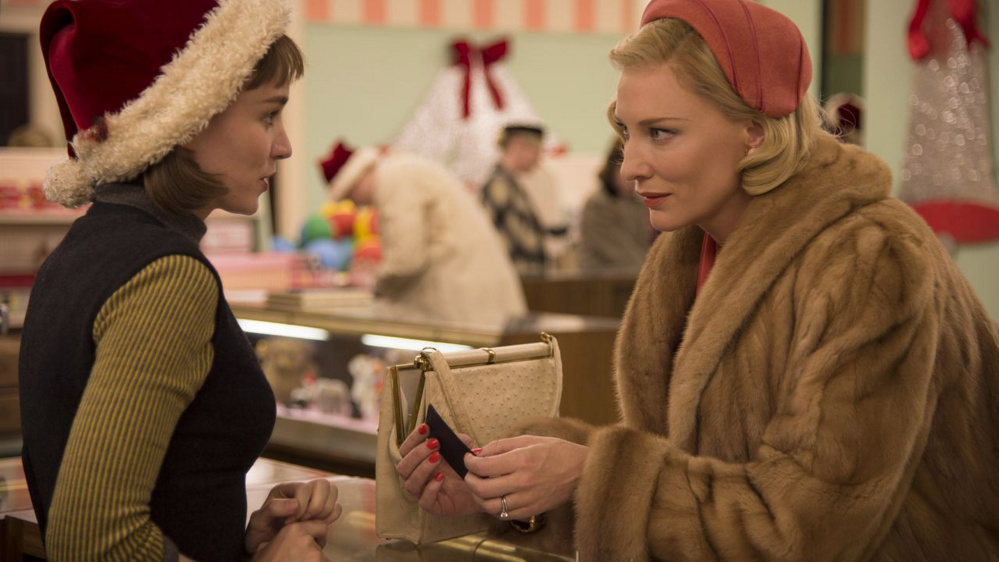“I have always depended on the kindness of strangers.”
—Tennessee Williams
In Todd Hanley’s “Carol,” Cate Blanchett is a wealthy, blonde suburban wife, not a housewife mind you. Carol is not the apron wearing type. Her clothes are this season’s, and they are perfectly fitted. Her makeup is so subtle it seems she was born with it.
We are in the Manhattan winter of 1953, a year and place I know so well that there is nothing in Todd Haynes’ Manhattan (even though it was shot in of all places, Cincinnati) that is not letter perfect, thanks to the magic of cinematographer Ed Lachman.
The pre-Christmas bustle on the streets, the yellow cabs, the men all wearing hats from J.J. Hat Center on 5th Avenue, topcoats from Bonds on Times Square. Thank you, costume designer Sandy Powell.
When we first meet, Carol is stumbling through a divorce from husband Harge (Kyle Chandler), a “Mad Men” type and an angry one confused by his wife’s bisexuality. It’s nothing new.
Carol once had a long romance, now faded, with Abby Gerhard (Sarah Paulson), her college roommate. But Carol has walked out of the cold into a new love.
We meet Therese Belivet, a shop girl from the Bronx who would rather be a photographer than a toy department clerk.
Across this crowded room they meet, and to paraphrase the famous song, “somehow they know, they know even then.” Carol’s eyes fall like snow on this young girl trying to get through the day while wearing a silly Santa hat and being bullied by a floor manager.
In a stunning soft focus shot across the room, their eyes meet, this tall, blonde society woman in a gorgeous mink coat that still smells of Chanel, cigarette smoke and winter’s wind and our gamin from the Grand Concourse with paper cut fingers and the smell of soap.
If you’re of a certain age and an old movie fan, you’ll instantly think Barbara Stanwyck meets Audrey Hepburn. It can’t be an accident that director Haynes gives us a Therese with short brown hair and perfect Audrey eyebrows.
Once Carol inhales the pure air around Therese, the relationship grows in spurts: lunches, dinner, walks in the park, tea at Carol’s house where husband Harge, smelling of Oak Room gin, encounters them, and still smarting from the last affair, becomes enraged and frightening.
The next day, Carol takes Therese on a Packard ride across America through shabby motels and diners and winds up in Waterloo, Iowa, where a gun hidden in lingerie appears and disappears.
Then suddenly we’re back in Manhattan, where the price of passion escalates.
In a nice touch, Haynes repeats a scene from the beginning, a moment in a restaurant where two hands touch Therese’s shoulder, Therese’s boyfriend’s (Jake Lacy) manly rub and Carol’s gentle seductive touch. An electric moment.
Rooney Mara’s Therese is flawless, touching. We can almost feel the lump in her throat and smell the Ivory soap on her hands. She won Best Actress for this at Cannes, and I’m sure more gold is on the way.
Cate Blanchett’s Carol is cool, almost detached in her pursuit of her shop girl, and is of course masterful.
Blanchett, always seductive, seduces us again, but she seems to be settling into the warm cashmere of being Blanchett, the enchanting perfectionist. In Woody Allen’s “Blue Jasmine,” she broke free and gave us a crackling “Blanche DuBois” for the iPhone years.
I never saw Todd Hanley’s “Far From Heaven,” and I hated “I’m Not Here,” but now I’m a fan. “Carol” is his new calling card.
The screenplay “Carol” by Phyllis Nagy is drawn from Patricia Highsmith’s novel “The Price of Salt.”
J.P. Devine is a former stage and screen actor and the author of “Will Work For Food.”
Send questions/comments to the editors.



Success. Please wait for the page to reload. If the page does not reload within 5 seconds, please refresh the page.
Enter your email and password to access comments.
Hi, to comment on stories you must . This profile is in addition to your subscription and website login.
Already have a commenting profile? .
Invalid username/password.
Please check your email to confirm and complete your registration.
Only subscribers are eligible to post comments. Please subscribe or login first for digital access. Here’s why.
Use the form below to reset your password. When you've submitted your account email, we will send an email with a reset code.